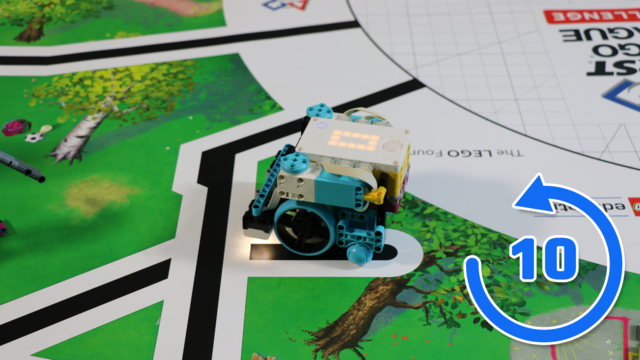This LEGO Education SPIKE Prime video tutorial demonstrates the difference in turning slow and turning fast and using the Motion sensor to understand the orientation of the robot. We do 10 consecutive runs. The goal is to understand what can you expect from the robot behavior in terms of consistency.
- #1926
- 02 Jun 2022
- 3:08
- LEGO Education SPIKE Prime
- Scratch, LEGO Education SPIKE App Word Blocks 2, Programming, Motion Sensor, Gyro Sensor
English
In this video tutorial, we will use the LEGO Education SPIKE Prime robot and its motion sensor and we'll do ten consecutive tries of the previous program of how we rotate the robot fast and slow to 90 degrees.
Let's do the 10 seconds on 60 plus first ten times very fast. As you remember from the explanation of the program from the previous tutorial, we have two programs uploaded on the robot. It's a one program, but we can control it with the left and right the button. So left and we rotate very fast and return back. Let's see again, very fast and return back and you see that it's not exactly the same each time, very fast and return back. So even though the robot is aligned in the same way, it is not in the same position. So this very fast way of moving the robot, it's fast, but it's not very accurate and it's not very consistent. It's consistent when it comes to the angle, but the robot is in a different position every time after we turn. This is because of the friction of the wheels, of the friction of the field. Again, that's a tool. You can use this tool if you need to turn the robot very fast because you want to save some seconds. But a different approach would be to turn the robot a little bit slower. Let's see ten consecutive runs of this example. How do we turn the robot slow, return and see the end position? Well, it's not exactly 90 degrees. That's a configuration for every robot. The point here is that it is more consistent when you turn slower. With robot, the end angle is more consistent and it's the same. The position of the robot is the same. Again, we try to align it each time to the black line.
And with these ten consecutive runs, what we hope is for you to see that sometimes it pays off to be a little bit slower with the robot and to turn slowly. Use the motion sensor to detect the degree to which you want to turn the robot. But if you are slower, you have less inertia, you get a much more consistent product. Again, check out the previous tutorial of how exactly the program works and how we've developed the program.
Курсове и занятия включващи този Урок
Този Урок е използван в следните курсове и занятия.

LEGO Education SPIKE Prime Programming for Competitions with Word Blocks
Two fundamental concepts are essential for robotics competitions: ensuring the robot consistently navigates and positions itself accurately on the field and designing attachments that complete missions once the robot reaches its target. This course focuses on the first aspect - precise navigation and positioning - while the second is covered across the entire FLLCasts platform, starting with the FIRST LEGO League with LEGO Education SPIKE Prime. "Challenge" competition for 9-16 years old
The goal of this course is to help you learn how to program LEGO Education SPIKE Prime robots to operate consistently and reliably in competition settings. We use LEGO Education SPIKE App Word Blocks, a Scratch-based programming language, to teach key techniques applicable to FIRST LEGO League and World Robot Olympiad competitions. Topics covered include different methods for line following, such as fast, slow, smooth, and using multiple states, as well as techniques for line alignment, double alignment, and maintaining a straight path using the motion sensor.
- 40
- 188:21
- 19

Motion Sensor - fast turn
Is it better to do fast turns or slow turns? Should you save some time by turning fast or should you be more precise by turning slow. Where is the balance? This video tutorial demonstrates exactly this for LEGO Education SPIKE Prime robot, their motion sensor and an ever occurring question on FIRST LEGO League competition which is how to find the balance and where is the balance.
- 2
- 0
- 1
- 3d_rotation 1